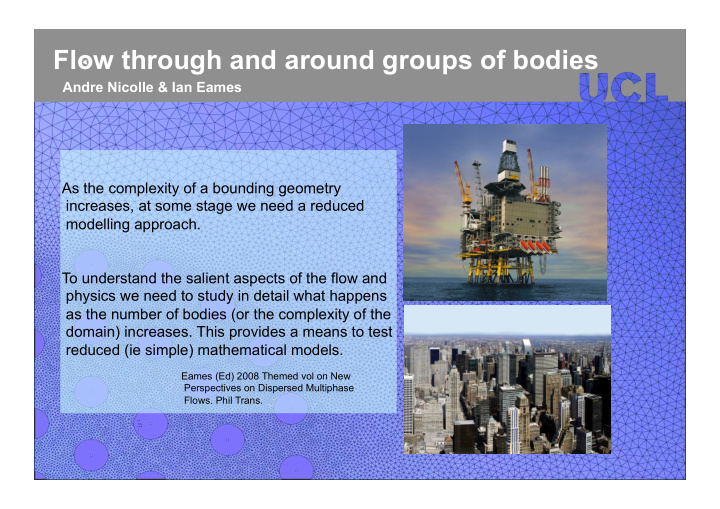



Flow through and around groups of bodies Door vortex Andre Nicolle & Ian Eames As the complexity of a bounding geometry increases, at some stage we need a reduced modelling approach. To understand the salient aspects of the flow and physics we need to study in detail what happens as the number of bodies (or the complexity of the domain) increases. This provides a means to test reduced (ie simple) mathematical models. Eames (Ed) 2008 Themed vol on New Perspectives on Dispersed Multiphase Flows. Phil Trans. t = 34 s t = 6 s
Flow past isolated and multiple bodies Physical processes Point force representation Magnaudet & Eames 2000 Ann Rev Fluid Mech Hunt & Eames 2005 JFM Vorticity annihilation
Numerical calculations We developed a parallel computational code, written in C++ using late binding object orientated method and high performance numerical libraries (PETSc, Intel MKL and MPI, ParMETIS, TetGen), was developed. The numerical method was validated against standard test cases on a small cluster before running high resolution simulations on Legion. The code is capable of fully resolving 2-D and 3-D fixed domains and domains on which surfaces move and deform. We used an ALE-CBS-FEM formulation for solving the Navier-Stokes equation. To ensure mesh quality was maintained, the domain was continuously checked and adaptively remeshed if required.
Configuration Re=100 for individual cylinder, Re_G=2100 for group 5-6 million nodes / run time about 6 days on 32 CPU or 18 hrs for 256 CPU’s (on Legion)
Modelling approach Add together the inviscid and viscous contributions Could be adapted to include vortex shedding by fluctuating drag / lift force. Use of integral constraints.
Flow past isolated and multiple bodies N=7 N=20 N=39 N=95 N=133
Flow past isolated and multiple bodies Flow shedding from Large shear layer isolated cylinder Individual wakes in near field
Maximum vorticity downstream Case 1 Case 1 S1 Case 1 Case 1 N=1 Case 2
Maximum vorticity downstream Case 1 Case 1 S1 Case 3
Average flow through the array Average velocity in array. Downstream, it is more useful to apply conditionally averaged approach (eg Hunt, Eames & Westerweel 2004 JFM; Eames & Flor 2010 Phil Trans Themed vol)
Integral measures of flow in array Eulerian average velocity average Lagrangian velocity Eames, Hunt & Belcher 2005 JFM
Experimental study
Conclusion Ratio of wake Individual bodies length to array need to be modelled size Eames, Roig, Hunt & Inviscid blocking Belcher 2006 NATO distributed drag important models void Inviscid blocking weak fraction 1. For high void fractions (>0.1), an average drag model is suitable but the difficulty is to choose the drag closure. 2. Flow low void fractions, the effects of individual bodies needs to described. 3. Both kinematic blocking and wake effects important and can be described in a simple manner.
Recommend
More recommend